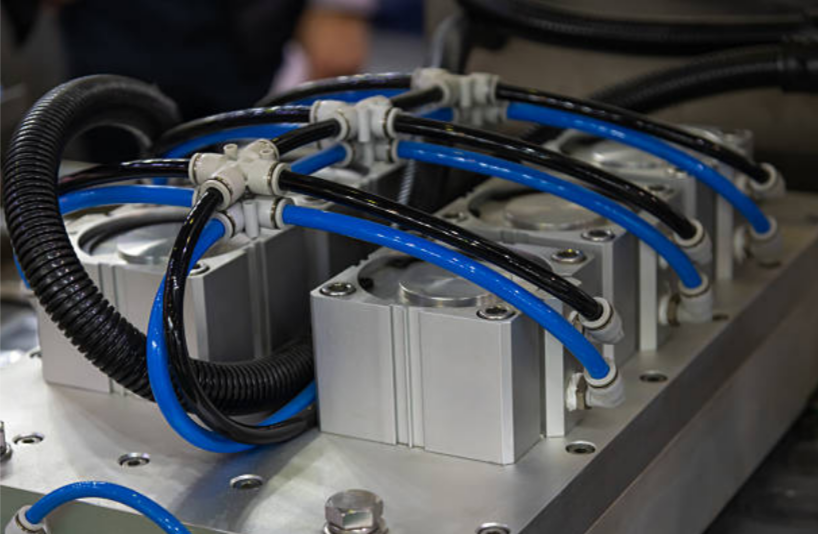Compact Cylinders: More Punch in Less Room

Factories never stop trimming inches, and designers can feel the squeeze. That constant need for smarter, tighter machines has pushed compact cylinders to center stage.
These short-stroke actuators pack a solid jolt of linear motion into a footprint so slim it almost disappears. Packaging lines, car plants, circuit board shops, and agile cobots all keep a set within arm’s reach.
Because those cylinders are becoming a daily tool rather than a side option, decision-makers now have to learn their quirks and perks. Knowing which model fits where can mean quicker layouts and still-faster production.
A compact cylinder trades length for power. Engineers chop a few centimeters off the housing, yet the push force remains right where it needs to be. That simple swap saves the kind of installation space that usually runs out first.
Compact cylinders usually come with a few handy features:
- A short body that slides into the trickiest corners without fuss.
- Double-acting operation so the piston pushes in both directions.
- ISO compliance to swap parts quickly without breaking the system.
- Mounting options like through-holes, flanges, or feet to fit almost anywhere.
- A surprising amount of punch for their size thanks to a smart piston design.
Because they zip back and forth fast, these cylinders suit high-speed jobs that crave steady, precise motion even when space runs low. Ordering from a trusted industrial automation parts supplier means you’ll get factory-tested units that play nice with the rest of your equipment.
Why Engineers Care About Shrunken Actuators
These days, shrinking the outline of machines isn’t just clever; it’s necessary. Every inch not wasted leaves room for something else that adds value.
Packing More Punch into Less Space
Manufacturers are pushing toward modular cells where every corner must earn its keep. Compact cylinders slash wasted air between components and squeeze extra capability into every square meter.
Enhancing Mobility in Automated Gear
Picture a warehouse where automated guided vehicles zip between shelves. If these machines can shed every unnecessary pound, they get faster and sip less battery juice. Swapping bulky rams for compact cylinders puts that goal within easy reach.
Tackling Maintenance Head-On
A small actuator slides into cramped corners that full-size units would never fit. That extra room lets technicians swap sensors, grease rods, or tighten bolts in minutes rather than hours. Shorter fixes keep the whole line running and spare managers the headache of unplanned downtime.
Slashing Material Bills
Fitting a petite cylinder often means ditching the heavy brackets and latticework that once braced a full-length rod. Steel and aluminum saved on one project can cover the metal for the next three jobs. When margins are tight, every ounce of scrap gold’s worth its weight in gold.
Buying Right the First Time
Nobody wants to gamble on motion parts that let the first prototype down. Sourcing from a tested industrial-automation vendor delivers performance curves you can trust, plus the customer-support safety net that stops problems from escalating.
Compact Cylinders in Fast-Moving Electronics Shops
Cleanrooms where cellphone screens are glued together leave hardly any spare cubic inches. Miniature pneumatic cylinders glide into that claustrophobic space and nudge a circuit board with the finesse of a watchmaker. When alignment can’t be off by a millimeter, a full-length ram is purely wasted bulk.
Pharmaceutical and Medical Devices
Cleanrooms live by their own rules. Gear has to move quietly, take up as little room as possible, and leave the air pristine. A short barrel cylinder slips into those narrow gaps, cutting volume while keeping the laminar flow on point.
Automotive Assembly
Assembly lines rarely afford extra elbow room. Slim-profile actuators sneak into tight bends and underneath frames without blocking an operator’s view. Those same space-saving designs tackle clamping, pressing, and quick part alignment on every sub-assembly head.
Food and Beverage Packaging
Speed is currency on packaging runs, and every last millimeter steals from that clock. Compact cylinders land in label applicators, bottle cappers, sort tables, and carton closers because they give fast, repeatable push in a hand-sized package.
Performance, across the board, is non-negotiable. Manufacturers lean on a proven automation supplier for pre-tested, corrosion-proof parts that keep pace with safety and hygiene codes.
Finding the Right Compact Cylinder
Picking a compact cylinder is part math, part gut check. Engineers weigh specs against the shrinking inches available, and the number crunching tells its own story.
Stroke versus Bore
Stroke length maps the distance the rod can fly; bore diameter gauges the muscle behind that travel. Match both metrics to the load your design lives with and the envelope that design can afford.
Mounting Flexibility
Do you need a cylinder that can clamp right to a face, bolt to a base, or hang from a rod end? Pick one with the right hardware built in and save yourself the headache of jury-rigging it to old machinery.
Material and Sealing
Dusty shops, muggy warehouses, or kitchens where spills are normal all punish ordinary metals and O-rings. Reach for stainless steel or anodized aluminum, then double-check the seal type to make sure nothing leaks or breaks.
Load Handling
Compact cylinders may look tiny, but slip on a guide rod or a set of bushings and they can shoulder side loads without whining or twist when they move. That extra gear turns a little piston into a tough workhorse.
Repeatability and Cycle Life
Fast-moving assembly lines repeat the same motion thousands of times, so wear and drift can add up in a hurry. Ask the supplier how many cycles their actuator lasts at your pressure and load, then snag the promise in writing if you can.
The right industrial-automation vendor will hand over detailed specs, offer real-world advice, and probably email you a CAD file before noon. It saves engineers guesswork and speeds up testing by a week or more.
Read Also: Technological Changes Altering Business in 2025
Role of the Trusted Supplier
Fitting all the parts into a cramped machine bay is tricky enough without wondering if the components will actually work together. Quality, support, and the peace of mind that someone stands behind the sale make a good supplier worth their weight in steel.
A dependable industrial-automation-parts supplier you can trust gives you several big advantages.
ISO-certified compact cylinders are always on hand, and their sizes never seem to shrink or grow at the worst moment.
You get clear documentation- up-to-date datasheets, 3D CAD models, and easy-to-follow maintenance instructions- without having to dig for them.
If you’re unsure about a spec, the same supplier will sit down and help line up the right product with your existing equipment.
Because he keeps a lean stockroom, the parts show up just in time, not weeks too late.
Long after the sale, the company tracks down replacements and answers phone calls at midnight when something jams.
Working with a company like this typically means decent warranties, visible quality stamps, and gear field-tested in conditions similar to yours.
Engineers jamming a compact cylinder into tight machine corridors should never gamble; a reliable supplier already road-tested the component and knows it’ll hold up.
Conclusion
Machines can’t slow down, and makers of those machines can’t catch their breath.
Automation is getting quicker, sharper, and- very annoyingly- smaller every day, and that’s where compact cylinders come in. They push heavy loads but somehow squeeze into the leftover space nobody thought would matter.
Whether the job is slapping labels onto moving bottles, choreographing fast-acting robots, or stacking up modules for a filling line, these narrow actuators fit like a glove.
Still, money spent on cheap off-brand cylinders can vanish faster than a deadline, so sticking with a trusted industrial-automation-parts supplier saves headaches most of all.
Sometimes, just a tiny push is all a project needs. The perfect mini actuator can turn an okay machine into something really impressive.





